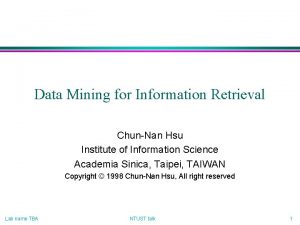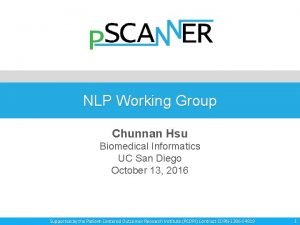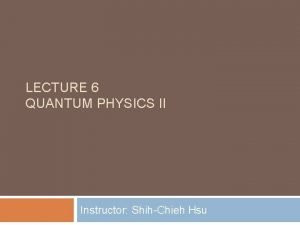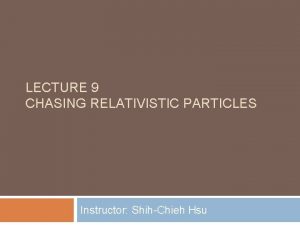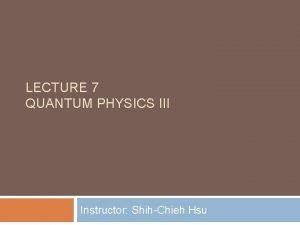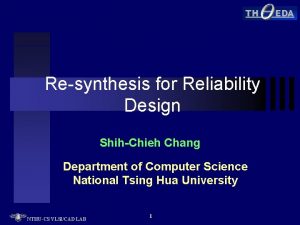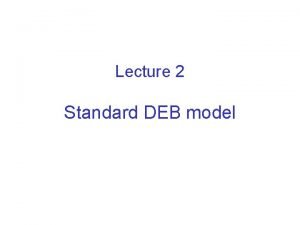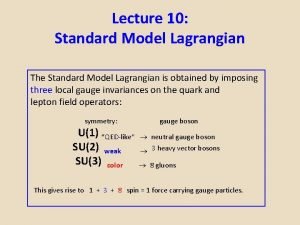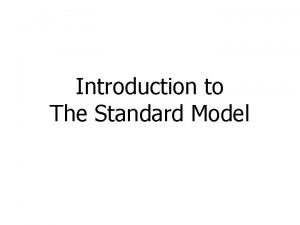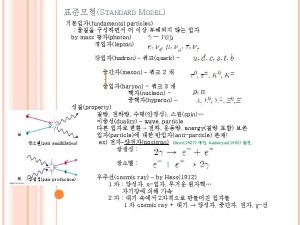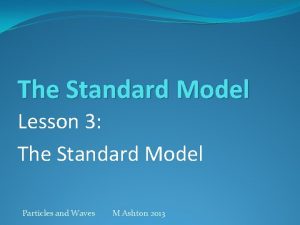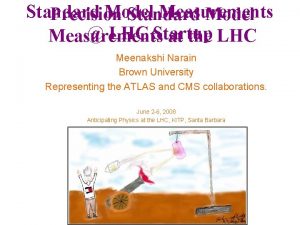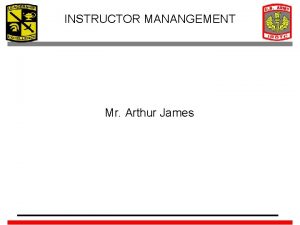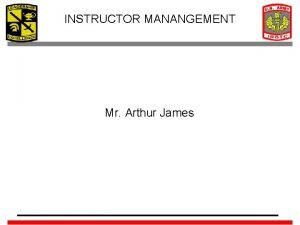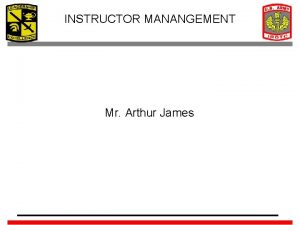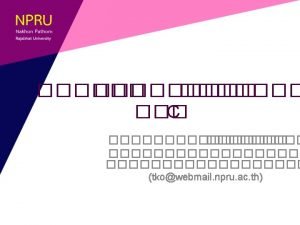LECTURE 8 THE STANDARD MODEL Instructor ShihChieh Hsu






























































- Slides: 62

LECTURE 8 THE STANDARD MODEL Instructor: Shih-Chieh Hsu

Announcement 2 ATLAS Virtual Visit (PAB B 305) 9: 20 am LHC – CMS Masterclass (PAA A 212) 10: 40 am Strongly suggest each of you bring your laptop At least two people in a group

The CMS Masterclass 3 Team-up with your seminar group At least one laptop per group (two laptops are better) Make sure your browser can run i. Spy software https: //catalyst. uw. edu/workspace/schsu/46264/3381 23 Read introduction and analysis tips before lectures Let’s re-discovery W, Z and H boson using CMS real data!

Lecture 8 4 Particle Adventure http: //www. particleadventure. org

5 New Quantum Theory (First Quantization)

First Quantization 6 The quantization of equation of motion of electron of atom is induced by the boundary condition of wave function from electric field of positive nucleus Successfully describe the spectrum of atom. Electron is moving in the speed v << c. Quantum Mechanics + Newtonian Relativity

Dirac Equation 7 Dirac tries to go beyond: Quantum Mechanics + Special Relativity -> Difficulty of negative energy -> Difficulty of develop motion of equation for photon

2 nd Quantization 8 From Particle to Field Single-particle to Many-particle theory Particle is an excitation (cluster of energy) of quantum field Each type of particle has a corresponding Field This leads to a complete quantum theory of electron and light!!!

Timeline 9

Timeline 10

The Modern Atom Model 11 If protons and neutrons a centimeter in diameter electrons and quarks would be less than the diameter of a hair the entire atom's diameter would be greater than the length of thirty football fields!

Scale of the atom 12 We don't know exactly how small quarks and electrons are; they are definitely smaller than 10 -18 meters, and they might literally be points, but we do not know. It is also possible that quarks and electrons are not fundamental after all!

What are we looking for? 13 We have now discovered about two hundred particles (most of which aren't fundamental). They are named with letters from the Greek and Roman alphabets. Enrico Fermi said “Young man, if I could remember the names of these particles, I would have been a botanist!"

The Standard Model 14 6 quarks. 6 leptons. The best-known lepton is the electron. We will talk about leptons in just a few pages. Force carrier particles, like the photon. We will talk about these particles later.

Quarks and Leptons 15 Everything you saw is made from quarks and leptons. Quarks behave differently than leptons, and for each kind of matter particle there is a corresponding antimatter particle.

Matter and Antimatter 16 Antiparticles look and behave just like their corresponding matter particles, except they have opposite charges.

What is Antimatter 17 evidence for antimatter in this early bubble chamber photo. The magnetic field in this chamber makes negative particles curl left and positive particles curl right. the "up quark" u has an "up antiquark”, pronounced u-bar. The antielectron is called a positron and is designated e+. )

Quarks 18 Quarks have the unusual characteristic of having a fractional electric charge Quarks also carry another type of charge called color charge,

Naming of Quarks 19 1964, Murray Gell-Mann and George Zweig suggested that hundreds of the particles known at the time could be explained as combinations of just three fundamental particles. Gell-Mann chose the name "quarks, " pronounced "kworks, " Gell-Mann George Zweig

Quarks Naming 20 There are six flavors of quarks. "Flavors" just means different kinds. The two lightest are called up and down. The third quark is called strange. It was named after the "strangely" long lifetime of the K particle, the first composite particle found to contain this quark. The fourth quark type, the charm quark, was named on a whim. It was discovered in 1974 almost simultaneously at both the Stanford Linear Accelerator Center (SLAC) and at Brookhaven National Laboratory.

Heavy Quarks 21 The bottom quark was first discovered at Fermi National Lab (Fermilab) in 1977, in a composite particle called Upsilon (). The top quark was discovered last, also at Fermilab, in 1995. It is the most massive quark. It had been predicted for a long time but had never been observed successfully until then.

Hadrons: Baryons and Mesons 22 Like social elephants, quarks only exist in groups with other quarks and are never found alone. Composite particles made of quarks are called (uud), protons Pion , which is made of an up quark and a down anitiquark.

Leptons 23 "Lepton" comes from the Greek for "small mass, " However, the tau lepton is more than 3000 times as massive as the electron. Quarks are sociable and only exist in composite particles with other quarks, whereas leptons are solitary particles.

Lepton Decays 24 the muon and the tau, are not found in ordinary matter at all. This is because when they are produced they very quickly decay, or transform, into lighter leptons. Physicists have observed that some types of lepton decays are possible and some are not. In order to explain this, three lepton families: the electron and its neutrino, the muon and its neutrino, and the tau and its neutrino. The number of members in each family must remain constant in a decay.

Lepton Type Conservation 25 We use the terms "electron number, " "muon number, " and "tau number" to refer to the lepton family of a particle. Electrons and their neutrinos have electron number +1, positrons and their antineutrinos have electron number -1,

Quiz 26 Which lepton decays are possible? Why or why not? Yes! Charge, tau number, electron number, and energy are all conserved. No! Muon number is not conserved. A muon has a muon number of 1, and thus the right side of the decay equation has muon number 1 No! energy is not conserved. A muon has a lot more mass than an electron,

Neutrinos 27 it was through a careful study of radioactive decays that physicists hypothesized the neutrino's existence. Because neutrinos were produced in great abundance in the early universe and rarely interact with matter, there a lot of them in the Universe. Their tiny mass but huge numbers may contribute to total mass of the universe and affect its expansion.

Quiz 28 What are protons made of? Protons are made of two up quarks and one down quark, expressed as uud. What are electrons made of? As far as we know, electrons aren't composed of smaller particles, they are fundamental! Which of the following are made of quarks? Baryons? Yes, they are made of three quarks put together. Mesons? Yes, they are made of one quark and one antiquark. Barons? Yes, the English nobility are also made of quarks.

The Four Interactions 29 What holds things together? What's the difference between a force and an interaction? a force is the effect on a particle due to the presence of other particles. The interactions of a particle include all the forces that affect it, but also include decays and annihilations that the particle might go through. the particles which carry the interactions force carrier particles.

Elementary Particles 30

How does matter interact? 31 How do two magnets "feel" each other's presence and attract or repel accordingly? How does the sun attract the earth? We know the answers to these questions are "magnetism" and "gravity, " but what are these forces? At a fundamental level, a force isn't just something that happens to particles. It is a thing which is passed between two particles.

The Unseen effect 32 You can think about forces as being analogous to the following situation: all interactions which affect matter particles are due to an exchange of force carrier particles

Electromagnetism 33 The carrier particle of the electromagnetic force is the photon Photons have zero mass, as far as we know, and always travel at the "speed of light", c, which is about 300, 000 meters per second, or 186, 000 miles per second, in a vacuum.

Residual EM force 34 Atoms usually have the same numbers of protons and electrons. They are electrically neutral, Since they are neutral, what causes them to stick together to form stable molecules? the charged parts of one atom can interact with the charged parts of another atom. This allows different atoms to bind together, an effect called the residual electromagnetic force.

What about the nucleus? 35 What binds the nucleus together? why doesn't the nucleus blow apart? Since neutrons have no charge and the positively-charged protons repel one another, So how can we account for this dilemma?

Strong and Color Charge 36 Quarks have an altogether different kind of charge called color charge The force between color-charged particles is very strong, so this force is "creatively" called “Strong” The force carrier is called “Gluon” composite particles made out of quarks have no net color charge (they are color neutral).

Color Charge 37 Gluons carry two colors "Color charge" has nothing to do with the visible colors, it is just a convenient naming convention for a mathematical system physicists developed to explain their observations about quarks in hadrons.

Quark Confinrment 38 Color-charged particles cannot be found individually. For this reason, the color-charged quarks are confined in groups (hadrons) with other quarks. These composites are color neutral. only baryons (three different colors) and mesons (color and anticolor) are color-neutral. ud or uddd that cannot be combined into color-neutral states are never observed.

Gluons and Quarks 39 The quarks in a given hadron madly exchange gluons. For this reason, physicists talk about the color-force field which consists of the gluons holding the bunch of quarks together. Quarks cannot exist individually because the color force increases as they are pulled apart.

Color exchange 40 When a quark emits or absorbs a gluon, that quark's color must change in order to conserve color charge. For example, suppose a red quark changes into a blue quark and emits a gluon. What is the color of the gluon? red/antiblue gluon (the image below illustrates antiblue as yellow). The net color is still red.

Residual strong force 41 the strong force binds quarks together because quarks have color charge. What holds the nucleus together? since positive protons repel each other with electromagnetic force, and protons and neutrons are color-neutral. The strong force between the quarks in one proton and the quarks in another proton is strong enough to overwhelm the repulsive electromagnetic force.

Weak Interactions 42 Weak interactions are responsible for the decay of massive quarks and leptons into lighter quarks and leptons. When a quark or lepton changes type (a muon changing to an electron, for instance) it is said to change flavor. All flavor changes are due to the weak interactions are the W+, W-, and the Z

Electroweak 43 In the Standard Model the weak and the electromagnetic interactions have been combined into a unified electroweak theory. Physicists had long believed that weak forces were closely related to electromagnetic force At very short distances (about 10 -18 meters) the strength of the weak interaction is comparable to that of the electromagnetic. at thirty times that distance (3 x 10 -17 m) the strength of the weak interaction is 1/10, 000 th than that of the electromagnetic interaction. At distances typical for quarks in a proton or neutron (10 -15 m) the force is even tinier.

Force Carrier Comparison 44 the weak and electromagnetic forces have essentially equal strengths. the strength of the interaction depends strongly on both the mass of the force carrier and the distance of the interaction. The difference between their observed strengths is due to the huge difference in mass between the W and Z particles, which are very massive, and the photon, which has no mass as far as we know.

Gravity 45 the gravity force carrier particle has not been found. Such a particle, however, is predicted to exist and may someday be found: the graviton. Why does the SM work without explaining Gravity? the effects of gravity are extremely tiny in most particle physics situations compared to the other three interactions, so theory and experiment can be compared without including gravity in the calculations.

Interaction Summary 46

Quiz 47 Which fundamental interaction is responsible for: Friction? residual electromagnetic interactions between the atoms of the two materials. Nuclear Binding? residual strong interactions between the various parts of the nucleus. Planetary orbits? the gravity that attracts them to the sun!

Quiz 2 48 Which interactions act on neutrinos? Weak and Gravity Which interaction has heavy carriers? Weak (W+, W-, and Z) Which interactions act on the protons in you? All of them. Which force carriers cannot be isolated? Why? Gluons, because they carry color charge themselves. Which force carriers have not been observed? Gravitons (Gluons have been observed indirectly. )

Interactions 49

Quantum Mechanics 50 "quantum, " which means "broken into increments or parcels, ” is used to describe the physics of very small particles A few of the important quantum numbers of particles are: Electric charge. Quarks may have 2/3 or 1/3 electron charges, but they only form composite particles with integer electric charge. Color charge. A quark carries one of three color charges and a gluon carries one of eight color-anticolor charges. All other particles are color neutral. Flavor distinguishes quarks (and leptons) from one another.

Spin 51 • Spin is a bizarre but important physical quantity. • Large objects like planets or marbles may have angular momentum and a magnetic field because they spin. • Since particles also to appear to have their own angular momentum and tiny magnetic moments, physicists called this particle property spin. • This is a misleading term since particles are not actually "spinning. " Spin is quantized to units of 0, 1/2, 1, 3/2 (times Planck's Constant, ) and so on.

Pauli Exclusion Principle 52 Pauli Exclusion Principle, no two particles in the same quantum state could exist in the same place at the same time. But it has been since discovered that a certain group of particles do not obey this principle. Particles that do obey the Pauli Exclusion Principle are called fermions, and those that do not are called bosons.

Fermions & Bosons Behavior 53

Fermions and Bosons: Explained 54 The predicted graviton has a spin of 2.

A Lot To Remember 55 We have answered the questions, "What is the world made of? " and "What holds it together? " The world is made of six quarks and six leptons. Everything we see is a conglomeration of quarks and leptons. There are four fundamental forces and there are force carrier particles associated with each force. We have also discussed how a particle's state (set of quantum numbers) may affect how it interacts with other particles. These are the essential aspects of the Standard Model. It is the most complete explanation of the fundamental particles and interactions to date.

Elementary Particles 56

Big Theory Chart 57

The Higgs Boson 58 Its discovery helps confirm the mechanism by which fundamental particles get mass.

The Higgs Boson 59 In 1964, six theoretical physicists hypothesized a new field (like an electromagnetic field) that would permeate all of space and solve a critical problem for our understanding of the universe. Photo of Francois Englert and Peter Higgs - © CERN

60 The Mechanism giving mass to Particle Interaction with the Higgs Field.

61 The Mechanism giving mass to the Boson How does the Higgs Boson get mass?

How to detect the Higgs Boson? 62
 01:640:244 lecture notes - lecture 15: plat, idah, farad
01:640:244 lecture notes - lecture 15: plat, idah, farad Rose hsu jordan
Rose hsu jordan What game do the members of the joy luck club play?
What game do the members of the joy luck club play? Dr te-shao hsu
Dr te-shao hsu Chun-nan hsu
Chun-nan hsu Jenny heidenreich
Jenny heidenreich Kompetenzstrukturmodell deutsch
Kompetenzstrukturmodell deutsch Teori francis hsu tentang psikososiogram
Teori francis hsu tentang psikososiogram Justine janelle
Justine janelle Ucsd vpn
Ucsd vpn Shih-chieh hsu
Shih-chieh hsu Vincent hsu md
Vincent hsu md Maylon hsu md
Maylon hsu md Simon hsu
Simon hsu Tipos de participantes en cursos de capacitación
Tipos de participantes en cursos de capacitación Basic instructor course tcole
Basic instructor course tcole Basic instructor course texas
Basic instructor course texas Basic instructor course texas
Basic instructor course texas Pepperball launcher nomenclature
Pepperball launcher nomenclature Neither of my two suitcases is adequate for this trip
Neither of my two suitcases is adequate for this trip Instructor vs teacher
Instructor vs teacher Cisco certified trainer
Cisco certified trainer Mptc instructor
Mptc instructor Tcole advanced instructor course
Tcole advanced instructor course Basic instructor course #1014
Basic instructor course #1014 Virtual art instructor
Virtual art instructor Nfpa 1403 instructor to student ratio
Nfpa 1403 instructor to student ratio Human factors instructor
Human factors instructor Instructor operating station
Instructor operating station Catia instructor
Catia instructor Instructor
Instructor Instructor responsibilities and professionalism
Instructor responsibilities and professionalism Tcole 1014 basic instructor course
Tcole 1014 basic instructor course Usmc jrotc vacancies
Usmc jrotc vacancies How to become an nrp instructor mentor
How to become an nrp instructor mentor Cisco instructor certification
Cisco instructor certification Cbrf wisconsin registry
Cbrf wisconsin registry Nra certified instructor logo
Nra certified instructor logo Naismith was an instructor of
Naismith was an instructor of Please clean the room before you live
Please clean the room before you live Tcole advanced instructor course
Tcole advanced instructor course Tcole advanced instructor course
Tcole advanced instructor course Jrotc marksmanship instructor course online
Jrotc marksmanship instructor course online Which line is longer illusion
Which line is longer illusion Calcaneum plural
Calcaneum plural Basic instructor course #1014
Basic instructor course #1014 Basic instructor course tcole
Basic instructor course tcole Delmar cengage learning instructor resources
Delmar cengage learning instructor resources Instructor office hours
Instructor office hours Hình ảnh bộ gõ cơ thể búng tay
Hình ảnh bộ gõ cơ thể búng tay Slidetodoc
Slidetodoc Bổ thể
Bổ thể Tỉ lệ cơ thể trẻ em
Tỉ lệ cơ thể trẻ em Gấu đi như thế nào
Gấu đi như thế nào Thang điểm glasgow
Thang điểm glasgow Hát lên người ơi
Hát lên người ơi Môn thể thao bắt đầu bằng chữ đua
Môn thể thao bắt đầu bằng chữ đua Thế nào là hệ số cao nhất
Thế nào là hệ số cao nhất Các châu lục và đại dương trên thế giới
Các châu lục và đại dương trên thế giới Công thức tính thế năng
Công thức tính thế năng Trời xanh đây là của chúng ta thể thơ
Trời xanh đây là của chúng ta thể thơ Cách giải mật thư tọa độ
Cách giải mật thư tọa độ 101012 bằng
101012 bằng




